Andy Smith
Mine action specialist |
| |
|
Injuries excavating
|
| |
|
Humanitarian
Demining
Injuries excavating
This
is not meant to be a horror-show so I have kept
the pictures of injury to a minimum. However, it can be a powerful
training aid if deminers are shown the risks that they run,
so a few images of injury are included.
My
opinions are based on studying the Database
of Demining Accidents that I began in 1998 and maintained for more than a decade. This is the only global compilation of accident
records and it is now large enough (more than 1000 casualties) for
it to be an accepted source of reliable information.
Demining
accidents are rare - but most of them occur when the deminer
is excavating to expose a mine. See also the 2018 Editorial in the James Madison University Journal of Conventional Weapons Destruction in which the discussion of PPE development and needs is brought up to date.
|
Excavation accidents
occur because:
The following are listed according to frequency.
1. The tool being used is inappropriate or is being used in an inappropriate way, such as digging vertically. Problems with training and supervision are implied.
2. The deminer is working too quickly and/or without appropriate
caution.
Problems with training and supervision are implied, but the deminer may also have been pressured to work quickly.
3. The deminer failed to pin-point the metal-detector indication correctly and so began excavating on top of the mine. Problems with training, supervision and equipment are implied.
4. The mine is very sensitive or is positioned on its side.
Some
mines may be damaged and become very sensitive.
A few other explosive hazards can also be sensitive to any movement. A mine on its
side can mean that a deminer is working correctly
and still initiates it.
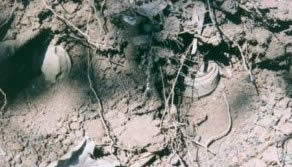
Injuries
occur because:
The following are listed according to frequency.
1. The
user's hand is too close.
At
4" (10cm), the blast forces from a PMN can strip the flesh
from fingers. If the tool is designed for another use,
such as a gardening or builder's trowel, the user's hand may be positioned
alongside the blade rather than a distance from it. Problems with procedures, logistics. training and supervision are implied.
2. The deminer is not wearing eye protection, or not wearing it correctly.
The
wearing of eye protection is by no means universal. Visors are often worn raised when the
user cannot see through it clearly (the material
is easily scratched). Problems of supervision and equipment provision are implied.
3. The deminer's
other hand is being used as a guide - and is too close.
A
short tool also brings the user's body very close to any
blast. Problems with procedures and supervision are implied.
4. The deminer
is leaning over the excavation. If
a short tool is used two-handed, the deminer is more likely
to be leaning over the detonation. Problems with procedures and supervision are implied.
5. The deminer's hand-tool breaks up and parts hit him.
Problems with equipment provision are implied. Deminers
have lost arms when parts of their tool has severely damaged
the upper arm (and have died as a result). They have had
deep chest penetrations from parts of the tool and its
handle. Other parts have hit deminers in the face, throat,
abdomen and thighs.
6. The deminer
stands or kneels on a missed-mine during the excavation.
Problems with procedures and supervision are implied. The
injuries that result from kneeling on a mine or standing
on it while in a crouching position are often fatal.
Anti-personnel blast mines can
cause horrendous injuries, but they rarely kill deminers.
However, some of the injuries are so disabling that the casualty
may die later as an indirect result.
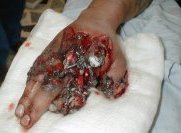
Severe
hand and arm injury is far too common. The blast forces can
strip the flesh from the bone.
Remember
that deminers are usually relatively unsophisticated and uneducated
people. Without their hands they have little chance of being
employed. In Moslem countries, the loss of a hand carries another
stigma and is greatly feared.

The
palm of this Afghan deminer's hand was saved simply in order
to avoid making him a potential thief, so a social leper.

The
second most common severely disabling injury in demining is
blindness.
No
matter how small the device, if a deminer detonates it without
eye protection, there is a very high chance of eye loss.
A grain of hot sand that would not even leave a scar if it hit the
casualty on the cheek, will pass through an eye and do permanent
damage.

The
black speckling on this man's face is often called a 'carbide
tattoo' because it used to occur when muskets or rifles backfired.
It is not carbide but hot soot - which is half burnt TNT, mine
casing, earth etc.
Reducing
injury
The causes identified above do not rule out deminer error, but the management systems in place should be designed to manage risk by correcting error before an accident occurs. Inadequate procedures, equipment, training and field supervision are contributory causes in most accidents and they are not the casualty's fault.
There
are two approaches to reducing injury - the first is to stop
the accident occurring by using improved procedures, equipment, supervision and training.
The second is to use PPE that reduces the severity of any injury that still occurs.
1. Tools
can be designed so that it is easiest to use them in a
manner than reduces the risk of initiating a mine.
2. Tools
can also be designed to reduce the risk of the tool itself
causing injury if an accident occurs.
These
requirements can coincide. For example, a long tool is hard
to use to dig vertically when on your knees - and it also puts
the user's hand at a distance from any explosion.
"Purpose
designed" is not necessarily safer.

This is a specialist pistol prod - the titanium blade
is held in jaws like a drill-bit in a chuck. Brittle materials
and a design than can separate mean that it was designed to
look 'sexy'", not to be safe or even comfortable to
use for long periods. The short length means that the user's
hand is too close, and makes it easier to prod the ground at
a steep angle.

Locally
made tools can be far more appropriate than expensive imports.
This is a locally made mild-steel prod used in Bosnia.
The picture shows it after an accident with one of the very
small AP blast mines prevalent in the Balkans. The handle is
a hard plastic. The blade is apparently mild steel and is slightly
bent. The safety is enhanced because it has a long blade and
the blade passes through the handle - so the tool did not separate.
The 'safety' element may have been unintentional because the
hard handle could easily have shattered.

This
prodding/excavation tool was made by a demining group in Afghanistan
when they found bayonets were hard to source. (The Taliban had
prohibited the sale of all weapons.) Its length makes it easier
to use at a shallow angle than the AK bayonet alternative.
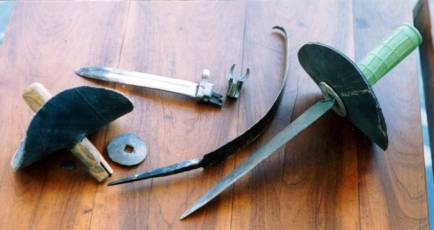
This
is the same kind of replacement for a bayonet - shown with an
example that was involved in an accident - and the remains of
an AK bayonet after an accident.
The Afghan tool is almost a very safe design, with a
long blade, a handguard made using the side-wall of a car tyre
and a bicycle handlebar grip over a wooden handle to improve
comfort. Unfortunately, it separates in a blast. But
the blade bent and the handle did not shatter - unlike the handle
of the AK bayonet
that shattered into fragments. Fragments
of hard plastic handles have penetrated several centimetres
into the user's chest, and the blade has chopped off fingers as it twists without a handle.
To
improve the Afghan probe, all that was needed was for the handle
and blade to be fixed together so that they could not separate.
Parts
that shatter or separate
Almost all of the commonly used tools will shatter or separate
in a blast. The condition of the tools is not always photographed
after an accident. Here are a few examples, mostly taken by
me.

This
is a typical African hoe - variations on which are used around
the world. Europeans may know them as a 'mattock'.
One famous demining group has often called them 'long trowels' in their
accident reports. The heads have separated and killed a deminer,
and the shaft splinters have caused severe injury.

This
is the type of 'long trowel' that the same demining group have
used in the Balkans. The photograph was taken after an accident.
The handle of the mattock that was used is shown in splinters above
an intact example. The wooden handle is dangerous even when
the tool stays intact. The user's hand was severely injured
in this accident.
Most
accidents with mattocks or pick-axes are probably caused by the
user failing to pinpoint a detector reading properly so starting to dig on top of the mine. Some have
occurred when metal-detectors have not been used and the entire
ground surface has been excavated. In general, the use of any two-handed
swinging tool invites imprecision.

This
was an ordinary garden trowel - often used around the world.
The user of this trowel lost several fingers. The mangled head
of the trowel was discovered inside his thigh when he
arrived at hospital several hours after the accident.

The
user of this mild steel trowel lost a finger - with a very small
AP blast mine.

This
is the same kind of trowel. Locally made, each purchase differed
and the welding on this example was poor. The two parts of this
trowel have been placed together for the photograph. The trowel
blade hit the user in the face, side-on. He was not wearing
a visor. His face was cut in half and he died later in
hospital.
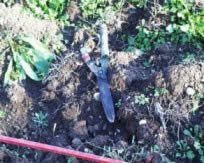
The
handle of these shears was torn away when they initiated a mine.
The mine was a bounding fragmentation mine and the victim died. It was not recorded whether damage was done to his hands.

More broken shears - notice that they broke at the weak point
where the metal stopped going through the handle.
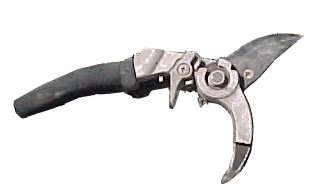
Secateurs
after a blast. The handles are cast aluminium so break easily.
Most
tool designs can be improved for demining purposes - and I have
proved that this can be done without incurring prohibitive costs.

This
is what my first 'prototype' design of needle probe looked like after detonating
a mine in a genuine accident. The handle is shatterproof MDPE.
The blade is E304 stainless steel which bends in an AP detonation
without the tip breaking away. The blade passes right through the handle and is too long to
turn-around and impale the user.
See also Handtools as PPE and Developing safer hand tools. Safer
designs of tool that can be made cheaply are shown at AVS
hand tool designs. They are free for anyone to copy, of course.
HOME
|
|